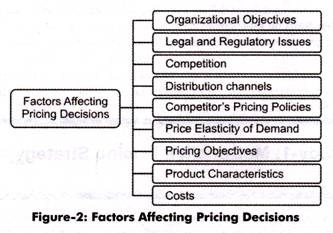Price is the only element of marketing mix that helps in generating income.
Therefore, a marketer should adopt a well-planned approach for pricing decisions.
The marketer should know the factors that influence the pricing decisions before setting the price of a product.
Figure-2 shows the factors that affect the pricing decisions:
Now, let us discuss the factors affecting the pricing decisions (as shown in Figure-2) briefly:
i. Organizational Objectives:
Affect the pricing decisions to a great extent. The marketers should set the prices as per the organizational goals. For instance, an organization has set a goal to produce quality products, thus, the prices will be set according to the quality of products. Similarly, if the organization has a goal to increase sales by 18% every year, then the reasonable prices have to be set to increase the demand of the product.
ii. Costs:
ADVERTISEMENTS:
Influence the price setting decisions of an organization. The organization may sell products at prices less than that of the competitors even if it is incurring high costs. By following this strategy, the organization can increase sales volumes in the short run but cannot survive in the long run.Thus, the marketers analyze the costs before setting the prices to minimize losses. Costs include cost of raw materials, selling and distribution overheads, cost of advertisement and sales promotion and office and administration overheads.
iii. Legal and Regulatory Issues:
Persuade marketers to change price decisions. The legal and regulatory laws set prices on various products, such as insurance and dairy items. These laws may lead to the fixing, freezing, or controlling of prices at minimum or maximum levels.
iv. Product Characteristics:
ADVERTISEMENTS:
Include the nature of the product, substitutes of the product, stage of life-cycle of the product, and product diversification.
v. Competition:
Affects prices significantly. The organization matches the prices with the competitors and adjusts the prices more or less than the competitors. The organization also assesses that how the competitors respond to changes in the prices.
vi. Pricing Objectives:
Help an organization in determining price decisions. For instance, an organization has a pricing objective to increase the market share through low pricing. Therefore, it needs to set the prices less than the competitor prices to gain the market share. Giving rebates and discounts on products is also a price objective that influences the customer’s decisions to buy a product.
vii. Price Elasticity of Demand:
Refers to change in demand of a product due to change in price.
There are three situations that arise under it:
a. Products that have inelastic demand will be highly priced
ADVERTISEMENTS:
b. Products that have more than elastic demand will be priced low
c. Products that have elastic demand will be reasonably priced.
viii. Competitor’s pricing Policies:
Influence the pricing policies of the organizations. The price of a product should be determined in such a way that it should easily face price competition.
ADVERTISEMENTS:
ix. Distribution Channels:
Implies a pathway through which the final products of manufacturers reach the end users. If the distribution channel is large, price of the product will be high and if the distribution channel is short, the price of the product will be low. Thus, these are the major factors that influence the pricing decisions.
